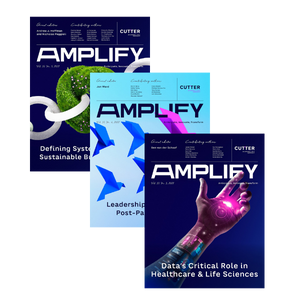This month's Cutter Benchmark Review marks the third installment in our annual series on IT budgets and the yearly IT budgeting process. The budgeting process is one of critical importance to IT and business professionals in our subscriber base. It is the importance of this process that leads us to address it each year. Doing so also allows us to comment on year-over-year changes and monitor how the priorities of the organizations we survey change over time. As you know if you follow CBR, we also have a yearly issue on IT trends and technologies that we publish at the beginning of each year.
Last year we commented on the continued recovery in IT spending and the strengthening of the previous year's changing focus from relentless cost-cutting and efficiency toward top-line revenue growth and innovation. Unfortunately, this year is different. While our global sample tampers and balances some of the results, we expect to see the effect of rising energy costs and the slowing US economy to take a toll on budgets, thereby dampening some of the previous year's momentum. Yet, there are many who suggest that not all is doom and gloom. A 7 April 2008 article by Thornton A. May in Computerworld concluded:
IT has always been a master of doing more with less. A slowing macroeconomic environment is, believe it or not, a great time to be in IT -- for virtualization and data center consolidation, and for customer segmentation and business intelligence projects.... Strategically astute companies know that an economic dip is the best time to make innovative IT investments that can create differentiation. If those investments are deployed when competitors are retrenching, they can grow the bottom line.
This is definitely a "glass half full" view of things, but whether you are in a "strategically astute company" or not, we hope that this issue of CBR will offer a systematic analysis of budget and spending trends that you can use within your organization. There is indeed some evidence that the yearly budgeting survey is proving useful. This month's survey yielded 103 responses, a further 5% over last year (when we had already had a 29% improvement in the number of responses). As our contributors indicate, 103 is still a relatively small number to draw reliable conclusions, and I hope that you will be supporting us more and more in the future with your responses.
In order to provide consistency with respect to the responses we seek, our contributors have identified a core set of survey questions we ask in each yearly survey. Recognizing that we will have fluctuations in importance of topics over time, part of the survey questions change each year, but our core set stays stable. Moreover, we feel that bringing back the same contributors every year gives stability to the survey and makes it easier to detect and extrapolate trends in the data. Our returning academic contributor is Dennis Adams, Associate Professor, Decision and Information Sciences, C.T. Bauer College of Business, University of Houston (USA). Dennis is a recurrent CBR author who contributes to our annual issue on IT trends as well as an accomplished executive education teacher and consultant in the areas of information systems management and information systems planning. Returning for the third year to provide us with a view from the field are Cutter Senior Consultants Bob Benson and Tom Bugnitz. Their consulting focus is on business value, effective IT application development, consulting methodology development, IT infrastructure planning, and facilitated planning.
Dennis begins his contribution by capturing the environmental uncertainty surrounding the current budgeting cycle. He then systematically analyzes the results of the survey drawing comparisons to last year's results. He addresses in particular how the focus on budget items changed from last year to this year in reaction to environmental changes and economic challenges. Dennis concludes his piece by commenting on the clearest statement of intention -- expressed by way of budget items -- that emerges from the survey concerning staffing, energy, cost-cutting, and budget centralization.
Bob and Tom frame their contribution around the IT governance challenge and how it is reflected in the budgeting process. In their words: "The implementation of governance decisions is ... the identification and definition of where money should be spent. In fact, prioritization means deciding in which order to spend money. Alignment means determining whether the money being spent is on behalf of the best areas, in best support of business strategies, and so forth." With this frame of reference established, Bob and Tom systematically analyze the survey results focusing on the IT budget management profile, connecting budget practices and structure with governance and value, and the role of steering committees in the budget process. Before concluding with valuable guidelines, they draw some comparisons to the 2006 and 2007 results.
Keeping with the tradition of CBR, our objective is not only to benchmark what is happening in order to give you some comparison data to evaluate your own organization, but also to provide practical guidance and food for thought as you define the optimal budget and priorities for your own firm. If, as the Computerworld article quoted here suggests, a slowing economy is an opportunity for IT, I hope this issue of CBR will help you see where that opportunity lies and also assist you in making the case in your organization to take advantage of it.








